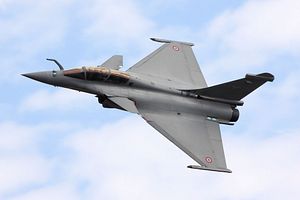India’s Medium Multi-Role Combat Aircraft (MMRCA) competition for 126 aircraft, won by France’s Dassault Rafale, was initiated by the erstwhile United Progressive Alliance (UPA) government in August 2007. The reason for the MMRCA bid was two-fold: addressing the fast decaying critical operations capacity of the Indian Air Force and simplifying the logistics of the tip in the “tip-of-the-spear” strategy.
The Indian Air Force (IAF) currently has a combat strength of 34 squadrons, of which only 31 are effectively combat ready. That leaves the IAF 11 squadrons short of the minimum 42 required to fight a two-front war against Pakistan and China. Meanwhile, the “tip-of-the-spear” strategy relies on advanced fighter and multi-role combat aircraft from Britain (the SEPECAT Jaguar), France (the Dassault Mirage 2000), and the USSR/Russia (the Mig-29 and the Mig-27) to carry out nuclear strikes and deep penetration of enemy airspace. The bulk of the IAF consists of 245 USSR/Russian made Mig-21s and 240 newer Russian Su-30MKIs. The strategy, therefore, creates major hurdles to sourcing spares and upgrading aircraft: India relies on a mélange of suppliers, from Russia and former Soviet republics to France, Britain, Israel, and the United States.
Aside from the MMRCA competition, India has responded to both these problems in an ad hoc fashion. India is undertaking major initiatives to modernize its air force that go beyond acquisition of new fighter jets. These steps include upgrading avionics, engines, and missiles on many of its fighter jets. The Mig-21 and 27 aircraft are being phased out in favor of the indigenously manufactured HAL Tejas. India is even considering procuring single engine jets to make up for the deficit at a lower cost.
The MMRCA competition formally commenced in 2011, with India issuing requests for information to the French company Dassault (for the Mirage 2000), America’s Lockheed Martin (for the F-16 C/D), Russia’s Mikoyan (for the Mig-29OVT), and Sweden’s Saab (for the JAS 39 Gripen). Subsequently, Dassault replaced the Mirage 2000 with the Rafale, and Russia replaced the Mig-29 with the Mig-35, while another American company, Boeing, offered the F/A-18E/F Super Hornet. The Rafale won the estimated $11-15 billion deal in 2012, and agreed to supply India with 126 aircraft, with 18 being delivered in “fly-away condition” and 108 manufactured in India.
However, on April 10, 2015, Prime Minister Narendra Modi announced the purchase of 36 Rafale aircraft in “fly-away condition” for $8.7 billion, instead of the aforementioned 126 fighters. Questions have been raised by the media and the political opposition regarding the cost of Modi’s 2015 deal compared to earlier one. The government argued that Dassault’s efforts to hike prices and its inability to stand guarantee to the 108 jets produced in India, in collaboration with the publicly owned Hindustan Aeronautics Limited, were key in scrapping the deal.
In terms of cost-accounting, some observers have critiqued the criteria used by the Indian Air Force to evaluate competing bids and the 30 year “life cycle” cost accounting method used by India. The cost of the 126 aircraft, including the 18 “fly-away condition” ones, appeared to have been $20 billion as opposed to the original $8 billion earmarked for the acquisition.
The cost-overrun was allegedly caused by the listing of more than 50-60 unpriced items as “miscellaneous,” which is ironically similar to the issue India faced with the 2005 acquisition deal for the French Scorpene submarine, currently being manufactured at the Mazagaon Docks. The Scorpene deal was also subject to allegations of kickbacks involving Abhishek Verma and senior members of the UPA administration, which were recently dismissed by the Delhi High Court due to insufficient evidence.
The uncertainty regarding the Rafale deal, however, threatens a broad and reliable France-India defense relationship. In terms of the Air Force and India’s nuclear capacity, the French Mirage 2000 provides India’s primary air-launched strike force, because the British SEPECAT Jaguars are slower at high altitudes and unable to deploy the unguided (gravity dropped) nuclear bombs used by India. The Kargil War of 1999 reaffirmed the capacities of the Mirage 2000-5 in ground attacks as well. However, Indian trepidation about corruption allegations prevented it from shifting the entire production facility, which France was shutting down, to India. Ironically, France has recently offered to donate 31 mothballed Jaguars, which India could upgrade with new radars, avionics, and even engines.
French weapons manufacturers also collaborate with private Indian companies and France has agreed to transfer the required technology. The French corporation Thales, which manufactures the Scorpene, reached an agreement in March 2016 with Reliance Defence Ltd., led by Anil Ambani, to make sonars for surface ships and submarines. Furthermore, a joint venture of Reliance Aerospace and Dassault Aviation — Dassault-Reliance Aeropace Ltd. — was inaugurated in October 2016 in order to manufacture radar and electronic warfare sensors for the 36 Rafale aircraft and become part of the global supply chain of Dassault’s civilian jet, the Legacy Falcon 2000 series.
The recently declared interest of Mukesh Ambani, who captains Reliance’s energy sector undertakings, in entering the defense sector, however, has also cast a shadow on the private sector aspects of France-India defense collaboration. Reliance’s interest in working with Russian energy conglomerates is problematic; Russia is one of the losing bidders for the MMRCA competition and continues to be interested in substituting the Su30-MKI for the Rafale.
Vasabjit Banerjee is an assistant professor of political science at Mississippi State University. His primary research interests are contentious politics and the local political-economies of state-formation in developing societies; specifically South Asia, Latin America, and Southern Africa.
Prashant Hosur is a doctoral candidate at Indiana University whose research focuses on International Relations and Comparative Politics, with a regional focus on South Asia.

































